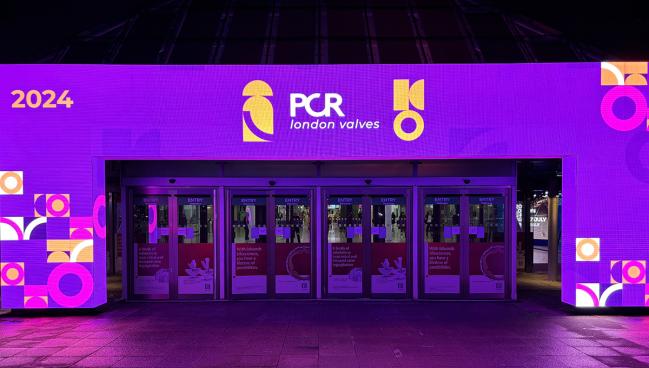Better 1-Year Echo and Clinical Outcomes With New Sapien Ultra Resilia
There was a higher risk of death with the older-generation valves, which investigators attribute to paravalvular leaks.

LONDON, England—Clinical and echocardiographic outcomes with the latest-generation balloon-expandable Sapien 3 Ultra Resilia were significantly better in a range of patients with severe aortic stenosis, including those at low risk for surgery, than in those treated with older-generation Sapien valves, a new study shows.
At 1 year, the risk of all-cause mortality and life-threatening bleeding was significantly lower with Resilia than with the Sapien 3 and Sapien 3 Ultra transcatheter heart valves (all Edwards Lifesciences), as was the risk of mild or greater paravalvular leak (PVL), reported investigators Monday at PCR London Valves 2024.
Gilbert Tang, MD, who led the analysis along with Annapoorna Kini, MD (both Icahn School of Medicine at Mount Sinai, New York, NY), said there have been questions raised about whether valve choice or valve technology matters when it comes to hard clinical endpoints: this study shows that it does.
“The interesting thing here is that there was a mortality difference, with a lower risk of death with the Resilia platform,” said Tang. “There were no differences in the risk of stroke. People might ask why, particularly since there was no difference in the risk of cardiac mortality. We attribute this to [the differences] in paravalvular leak.”
When investigators stratified outcomes based on discharge PVL, there was a significantly higher risk of death in those with mild or greater PVL compared with those without any PVL (14.0% vs 9.4%; P < 0.001). In low-risk patients, all-cause mortality was nearly doubled in those discharged with mild or greater PVL compared with those with none (8.0% vs 4.1%; HR 0.49; 95% CI 0.35-0.67).
“We know that moderate or worse PVL is not a good thing for patients,” Tang told TCTMD. “What this shows is that mild is not good either, especially in low-risk patients. . . . The [Ultra Resilia] technology allows us to reduce PVL, and that translates to a hard clinical endpoint, which I think is impactful.”
Aiming to Improve Long-term Durability
The latest-generation valve is made of Resilia bovine pericardial tissue, which is the same tissue used in the company’s surgical aortic valve. The leaflets are treated with a calcium-blocking technology, which is intended to reduce the risk of structural valve deterioration resulting from calcification and to improve long-term durability. It also includes a taller external skirt to limit PVL.
As a community, we need to strive to make the first valve, the first TAVI, as durable as possible, just like we do in surgery. Gilbert Tang
The 30-day results showed the latest-generation device had lower rates of PVL, lower echo-derived gradients, and larger effective orifice areas across all valve sizes when compared with the Sapien 3 and Sapien 3 Ultra devices.
The new study, which was published simultaneously in JACC: Cardiovascular Interventions, focused on 1-year outcomes of patients treated with Resilia or Sapien 3/3 Ultra in the Society of Thoracic Surgeons/American College of Cardiology TVT registry.
In total, 4,598 patients who received the Sapien 3 Ultra Resilia were propensity-matched to the same number of patients treated with Sapien 3/3 Ultra. The mean STS score was 3.6%, mean age was 76.7 years, and 38.6% of patients were female. Slightly more than one-third of patients (37%) were considered to have low surgical risk by the local heart team.
At 30 days, the mean gradient was significantly lower with Resilia than with Sapien 3/3 Ultra (10.2 vs 12.6 mm Hg; P < 0.0001). That difference was sustained out until 1 year (10.8 vs 13.1 mm Hg; P < 0.0001).
The rate of mild or greater PVL at 1 year was significantly lower in those treated with Resilia (15.6% vs 18.5% with Sapien 3/3 Ultra; P = 0.02) as was the risk of life-threatening bleeding (2.0% vs 2.7%; P = 0.03). While there was no difference in paired clinical outcomes at 30 days, a mortality benefit favoring Resilia emerged at 1 year (7.6% vs 9.7% with Sapien 3/3 Ultra; P = 0.004). There was no difference in the risk of cardiac mortality and no difference in stroke.
Use of the Sapien 3 Ultra Resilia was associated with a lower predicted risk of death at 1 year, while mild or greater PVL at discharge was associated with a higher risk of death in the overall cohort and in those at low surgical risk.
“I think this really tells a story,” said Tang. “Even in a balloon-expandable platform, you don’t want to have PVL leaving the procedure, and certainly not at 1 year if you can avoid it, because there will be an increase in mortality if you have a mild or greater paravalvular leak.”
I think this is an ongoing debate and I don’t think that we are able to make a final conclusion on the impact of mild PVL. Won-Keun Kim
While some might argue that mild PVL might not matter for elderly patients given their reduced life expectancy, the mortality signal is particularly relevant for younger, low-risk patients undergoing TAVI, said Tang.
Clinical Meaning of Study
Won-Keun Kim, MD (University of Giessen, Germany), who moderated the featured research session, said the link between mild PVL and adverse clinical outcomes is controversial, with some studies suggesting it is associated with worse clinical outcomes, and others not. The present study should be considered hypothesis-generating, he said, noting that the registry analysis doesn’t establish a causal relationship between mild PVL at discharge and mortality.
“I think this is an ongoing debate and I don’t think that we are able to make a final conclusion on the impact of mild PVL,” he told TCTMD.
At a minimum, the study shows that there is a difference in valve hemodynamics between Resilia and Sapien 3/3 Ultra. In practice, Kim said their goal is to achieve the best possible outcome, noting that the patient’s baseline risk, age, and life expectancy all factor into how aggressive they’ll be with optimizing valve implantation.
Karan Rao, MD (Royal North Shore Hospital, Sydney, Australia), who wasn’t involved in the study, said he would like to better understand to what extent moderate or severe PVL drove the increased risk of mortality.
“In other words, if someone had mild PVL versus no PVL, was there still a difference, or was it driven by the patients with a higher degree of PVL?” he told TCTMD. “The goal is to leave no PVL, that’s always the goal, but practically, most implanters often accept mild because you bring in the risk of annular rupture or conduction disease with postdilatation.”
However, as TAVI moves into younger and younger patients, physicians also recognize that mild PVL may become increasingly relevant, as there is more time for it to worsen and potentially cause problems, said Rao.
Tang said that at his center, postdilatation is routine, irrespective of PVL, to optimize frame expansion. While there might be a concern about certain risks with postdilatation, TAVI patients deserve to have the first valve implanted properly, he said.
“Not everyone can get a redo TAVR,” said Tang. “As a community, we need to strive to make the first valve, the first TAVI, as durable as possible, just like we do in surgery.”
Michael O’Riordan is the Managing Editor for TCTMD. He completed his undergraduate degrees at Queen’s University in Kingston, ON, and…
Read Full BioSources
Kini AS, Tang GHL, Yaryura R, et al. One-year, real-world outcomes of TAVR with the fifth-generation balloon-expandable valve in the United States. J Am Coll Cardiol Intv. 2024;Epub ahead of print.
Disclosures
- Tang reports receiving speaking honoraria and serving as a physician proctor, consultant, advisory board member, and steering committee member (RESTORE, APOLLO, IMPACT MR) for Medtronic; receiving speaking honoraria and serving as a physician proctor, consultant, advisory board member, and TRILUMINATE eligibility committee member for Abbott Structural Heart; serving as an advisory board member for Boston Scientific and JenaValve; serving as a consultant and physician screening committee member for Shockwave Medical; and consulting for NeoChord, Peija Medical, and Shenqi Medical Technology; and receiving speaking honoraria from Siemens Healthineers.





Comments